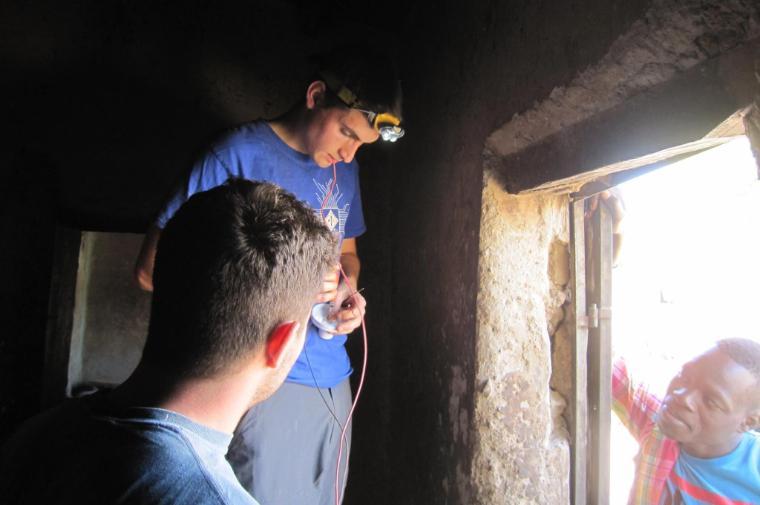
Lighting the Way in Rural Benin
They wanted to do something significant. They wanted to use what they have learned for something that mattered. So electrical engineering seniors Jacob Leatherberry and Nicolas Metais sought help with ideas from the late Jim Reites, S.J., associate professor of religious studies and engineering, who died on April 15 of this year.
Reites had facilitated a number of energy-related student projects in Africa, and it just so happened that a fellow Jesuit from Benin, Fr. Constant M.K. Bossou, currently pursuing his master's degree in computer engineering at SCU, knew of a perfect opportunity. But it would require support from more than a dozen others in Benin: Fr. Boussou's college classmates now in the Benin Electric Department, Jesuits in Cotonou, Brothers from a nearby Pastoral Center, Sisters of Charity Novitiate in Alafiarou, and village leaders. All together under the advisement of Reites and electrical engineering professor Tim Healy, Letherberry and Metais brought electricity to Alafiarou in rural northeastern Benin. Their senior design solar microgrid project now lights the night and charges cell phones for 133 villagers.
There were some stumbling blocks. The students promised a system that could generate, store, and distribute electricity for 10 houses. What they didn’t realize: In Benin, the term "house" equates to "family" … and those families are big—commonly 50 individuals at least. The deliverable was revised to 13 buildings. But which 13? On the ground, Leatherberry and Metais had decisions to make. "We spent an entire day out of the five we were there deciding where the system would go and what families would get lights. The village is split fifty-fifty between Muslims and Christians, and they get along really well, so we had to pick a mix to avoid risking any conflict," said Leatherberry.
Over the next few days, they didn't get much sleep. They would work on the installation all day then go back to their lodgings and continue perfecting the design until midnight or three in the morning. All was running smoothly until they went to boot up the system on the night before they were to leave the country. Flipped switch. Bright, flickering lights. Then … nothing.
"Shattered" is how Metais describes their reaction. "We were exhausted, but we were running around checking everything we could think of. Finally we decided to go home and think about it and do some more research."
Before they left, Metais said, a villager told them, "You guys are going to come back tomorrow, and if God wants it, it will work."
The next morning the pair discovered that the 24-volt light bulbs they had bought were actually only 12-volt. "Basically, we cooked a bunch of bulbs," Metais explained, "but we had a lot of spares. So we reconfigured our system to run on 12 volts, and it worked great." On that day, at least, engineering on-the-fly ended in a feeling of relief. "It was 16 hours of pandemonium," he said, "and we were so afraid of letting them down, but it all worked out."
Providing electricity was one thing, but keeping the system running and growing was another of the team’s goals, so they implemented a sound economic plan. The electricity is not free; it costs about 50 cents per bulb per month. A small portion of the proceeds are used to employ Parfait, an electrician and Brother from the neighboring Pastoral Center, who collects payment, monitors and maintains the system, and has the key to divert power away from those not paying their bills. "Before we left, we told the villagers that if they didn't take hold of it, the project could decline. If a family can't afford to pay their bill, the community should get involved and help them pay. It's important to keep money coming in so expansion can continue," said Metais. Leatherberry added, "We impressed on them that the money is their money; it's not anyone else's, and this is just the beginning of something much greater. We way over-spec'd the system to enable expansion."
Just weeks after the Broncos returned home, Fr. Reites received good news from Alafiarou: "A meeting was held under the mango tree to discuss expansion. Two buildings near the initial installation will receive 13 more bulbs. Parfait will purchase the equipment and installation will begin. A team of three officials has already been established to ensure no one sleeps with the lights on. The people are very happy."
The SCU team is very happy, too. "We designed this open-source project as a proof-of-concept so it could be replicated in other villages, or expanded by future SCU senior design teams. This is just the genesis of the project; we hope it goes much further than we can anticipate," said Leatherberry.
Ed. note: For more on Fr. Reites' death, which coincided with our press time, please visit scu.edu/engineering/reites